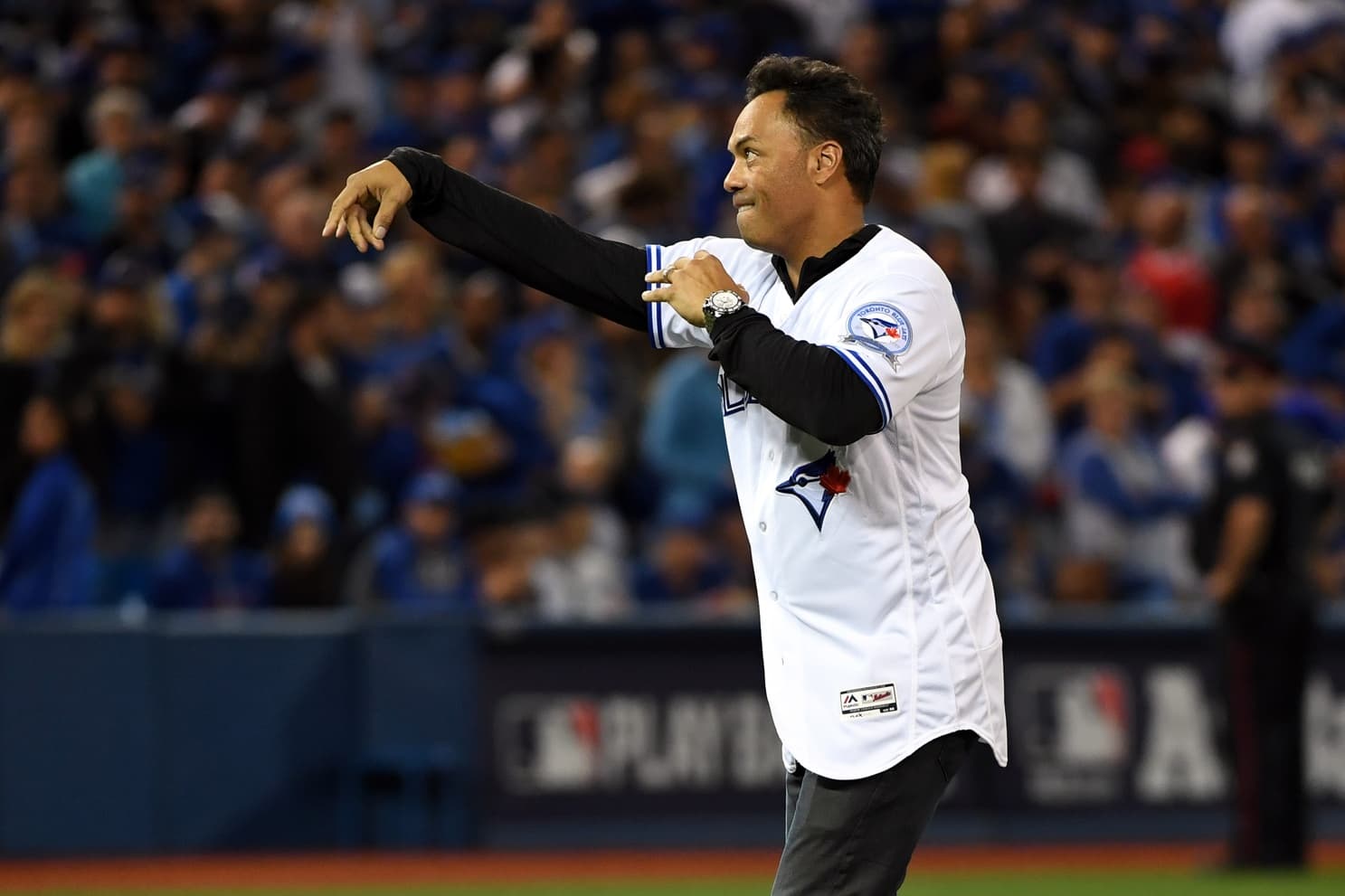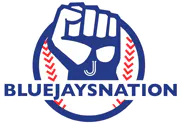There’s No Right Answer To The Question Of Who Is The Greatest All-Time Blue Jay, But There Is A Wrong Answer

Photo credit: Nick Turchiaro-USA TODAY Sports
Jun 9, 2017, 21:25 EDTUpdated: Jun 9, 2017, 21:51 EDT
We’re in the midst of the Blue Jays’ 40th anniversary season, and as part of what one can only assume are a number of things Sportsnet is doing to commemorate it, they’ve produced a rankings page called 40 in 40, in which fans are supposed to rank the greatest Blue Jays players in franchise history.
The Tao of Stieb has written about it this week, going slightly off-brand in making the case for Roy Halladay as the greatest ever Blue Jay. He does a great job walking us through his list, and does an especially great job of putting his head down and whipping past the fact that Roberto Alomar is “the current consensus pick as number one,” even though on his personal list, the Tao ranks him fifth.
Alomar, he says, “slips on my list in part because some of his best attributes seem better in the memory. We likely valued stolen bases and batting averages to a far greater degree in the nineties, but comparing Alomar’s wOBA or wRC+ slides him down the list slightly.”
No muss. No fuss. Moving right along. (No mention of defence, oddly, either.)
But this, for me, is the part of the exercise that’s truly the most interesting. There are four players in Blue Jays history that I think are head and shoulders above the rest: Dave Stieb, Roy Halladay, José Bautista, and Carlos Delgado. Personally, I’d consider putting Tony Fernandez ahead of Alomar, as well.
And, frankly, if Josh Donaldson ends up playing out his full contract in Toronto, I’ll happily slide him ahead of Alomar too.
Don’t get me wrong, though. I love Robbie Alomar! I have a whole lot of great memories of watching him — though, sadly, one of them isn’t his epic home run off Dennis Eckersley in Game Four of the 1992 ALCS. Dumb kid that I was, at some point after the Jays went down five or six to one, I gave up on the game and went outside (kids used to do that back then), only learning of the comeback from a friend’s brother much later. GAH!
Anyway, put a statue of Alomar with his arms in the air outside of the Rogers Centre and I’ll fuckin’ salute it every time I go by. (Also: seriously though, put a statue of Alomar with his arms in the air outside of the Rogers Centre.)
Let’s get another thing straight here: this isn’t a WAR thing. This isn’t a new school guy sneering at how flawed Alomar’s defensive reputation is according to the data now available. I’m not sure I believe Alomar’s reputation was flawed — that he was actually an overrated defensive second baseman. I just don’t think that even the most optimistic view of his defence gives him enough of a boost to pass the four guys who are clearly on top.
But WAR is a good place to start this discussion, because the defensive component of it is truly what’s at odds with our conception of Alomar. In four of Alomar’s five seasons in Toronto, the defensive component of his WAR is in the negative. In fact, that’s true of most of Alomar’s seasons in the majors. The method retroactively used to gauge defensive value — Total Zone Rating (expained here), which is supposedly fairly accurate during Alomar’s heyday, as Retrosheet includes “project scoresheet zones,” a rather sophisticated system of notation for balls in play (detailed here) — simply doesn’t like him. We could examine why, I suppose, but that’s not really the point. I’m willing to give Alomar credit for being quite a lot better than Total Zone does, and he still falls short of the other Blue Jays greats.
And that’s me being generous, I think! The list of career leaders by Total Zone certainly passes the smell test. Brooks Robinson, Andruw Jones, Mark Belanger, Ozzie Smith, and Roberto Clemente are the top five. And while five names hardly constitutes a vigorous study, that’s a pretty good top five.
So with his WAR getting dinged by its view of his defence, here’s how Alomar’s Blue Jays career looks:
FanGraphs WAR | Baseball Reference WAR | |
1991 | 4.3 | 4.5 |
1992 | 6.1 | 6.6 |
1993 | 5.7 | 6.1 |
1994 | 2.0 | 2.2 |
1995 | 2.2 | 2.7 |
Total | 20.3 | 22.1 |
Time for some quick and dirty math. At Baseball Reference they list what’s called a player’s offensive and defensive WAR. Both of these numbers include a positional adjustment, so we can’t simply add them up to get a player’s total WAR, or we’d be counting the positional adjustment twice. We can, however, get a sense of the relationship between the two numbers.
In a year like 1988, Alomar’s rookie season, Total Zone liked him a lot. He was the third best defensive second baseman in baseball according to it. His dWAR for that season was 1.3. His oWAR was 3.4. His actual WAR was 4.3. If you check out the other seasons where he was graded really well by Total Zone, you find that his defensive WAR was in the 1.0 to 1.5 range. And if you add his oWAR and dWAR together and subtract the difference betwen that figure and his actual WAR, it usually comes out to about a half a win. It varies, but as this is quick and dirty math, let’s do this: let’s make it so that for each season as a Blue Jay, Alomar’s defensive WAR was the same as that 1.3 figure he put up in 1988, instead of what Total Zone actually says it was. Then we’ll add that number to his oWAR, take off half a win, and we’ll have some kind of a filthy number that approximates what his WAR would look like if Alomar was as good defensively according to Total Zone as he is in our memories.
Sound like a plan?
OK, let’s try it.
Actual oWAR | Actual dWAR | Adjusted dWAR | oWAR + Adjusted dWAR | Adjusted Total (i.e. -0.5 WAR) | |
1991 | 5.1 | -0.1 | 1.3 | 6.4 | 6.1 |
1992 | 6.6 | 0.5 | 1.3 | 7.9 | 7.4 |
1993 | 7.0 | -0.4 | 1.3 | 8.3 | 7.8 |
1994 | 2.9 | -0.4 | 1.3 | 4.2 | 3.7 |
1995 | 3.5 | -0.4 | 1.3 | 4.8 | 4.3 |
Total | 29.3 |
OK, so we’ve just written some fan fiction about Roberto Alomar being seven wins better over his Blue Jays career than he actually was. And still, look at the result: 29.3 wins. An impressive total, even if it’s one that we’ve completely fabricated!
And yet…
In his time as a Blue Jay, Baseball Reference pegs Carlos Delgado at 36 WAR. Tony Fernandez and José Bautista are both at 37. Roy Halladay is at 48. Dave Stieb is at 57.
Adjusted Alomar’s total is still behind Jimmy Key and Jesse Barfield, and only edges past Vernon Wells by less than a win.
Granted, on a per-plate-appearance basis, Alomar is ahead of most. The Jays got a really good chunk of his Hall of Fame peak (though 1994 and 1995 weren’t much to write home about — y’know, unless you gift him value out of thin air like I’ve been doing!), and there’s no disputing that he was a great player. A tremendous player. One of the four or five (or six) best players in Blue Jays history. But even bullshit “Adjusted” Alomar trails Tony Fernandez by eight wins, and the real Alomar is another seven back. FIFTEEN WINS BEHIND TONY!
Of course, the World Series counts for something. That ALCS home run counts. Our memories count. The Hall of Fame counts. The peak counts. The value per season counts (though if you go too far with that argument both Donaldson and Roger Clemens will leap ahead of him). All of it counts! It’s not only about Wins Above Replacement and advanced statistical bullshit, I assure you. In fact… that’s exactly why I’ll grant that he’s better than the 14th best player in franchise history — which is what his rWAR total says. Making the argument that he should shoot all the way up to the top of the list, though, is a whole other story.
And the thing about the peak is, if you look at the best seasons by position players (again, according to Baseball Reference’s version of WAR), he has three in the Jays’ all-time top 50. They rank: 10th, 18th, and 49th. Bautista and Donaldson have two in the top ten (and so does Jesse Barfield, actually). And Stieb and Halladay are simply on another planet, in terms of what they accomplished in their careers as Blue Jays.
I don’t want to keep running down a true franchise great here, and I understand that the list is subjective and you can invent whatever criteria you want to keep your precious Alomar at the top of it, if that’s a thing that you really want to do. But is he the best Blue Jay of all time? No, you weirdos! Not even close!
(Well… OK, fourth or fifth is close to the top of a list of, like hundreds of players, I suppose, but you know what I mean.)
Breaking News
- Where do the Blue Jays find their next Max Scherzer?
- Blue Jays: 4 important instances to reflect on before putting Game 7 to bed
- Blue Jays gain early offseason win with Shane Bieber opting in
- Shane Bieber forgoes free agency, opts into $16-million 2026 player option
- Should the Blue Jays re-sign Bo Bichette?
